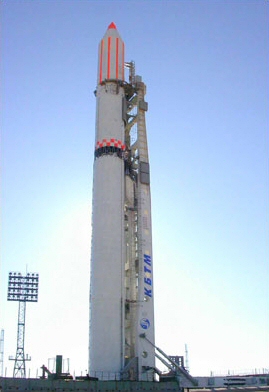Zenit-2

Zenit-2 at Site 45/1
|
|
| Function | Carrier rocket |
|---|---|
| Manufacturer | Yuzhnoye |
| Country of origin | (Ukraine) |
| Size | |
| Height | 57 metres (187 ft) |
| Diameter | 3.9 metres (13 ft) |
| Mass | 460,000 kilograms (1,010,000 lb) |
| Stages | Two |
| Capacity | |
| Payload to LEO | 13,740 kilograms (30,290 lb) 11,420 kilograms (25,180 lb) (ISS orbit) |
| Payload to SSO | 5,000 kilograms (11,000 lb) |
| Associated rockets | |
| Family | Zenit |
| Derivatives |
Zenit-2M Zenit-3SL |
| Launch history | |
| Status | Retired |
| Launch sites | Baikonur Site 45 |
| Total launches | 36 |
| Successes | 28 |
| Failures | 7 |
| Partial failures | 1 |
| First flight | 13 April 1985 |
| Last flight | 10 June 2004 |
| First stage | |
| Engines | 1 RD-171 |
| Thrust | 8,180 kilonewtons (1,840,000 lbf) |
| Specific impulse | 337 sec |
| Burn time | 150 seconds |
| Fuel | RP-1/LOX |
| Second stage | |
| Engines | 1 RD-120 1 RD-8 |
| Thrust | 912 kilonewtons (205,000 lbf) 79.5 kilonewtons (17,900 lbf) |
| Specific impulse | 349 sec |
| Burn time | 315 seconds |
| Fuel | RP-1/LOX |
The Zenit-2 is a Ukrainian, previously Soviet, expendable carrier rocket. First flown in 1985, it has been launched 37 times, with six failures. It is a member of the Zenit family of rockets, and was designed by the Yuzhnoye Design Bureau.
With 13-15 ton payload in LEO it was intended as up-middle class launcher greater than 7-ton payload middle Soyuz and smaller than 20-ton payload heavy Proton. Zenit-2 would be certified for manned launches and placed in specially built launch pad at Baykonur spaceport, carrying the new manned partially reusable Zarya spacecraft that developed in end of the 1980s but was canceled. Also in the 1980s Vladimir Chelomey's firm proposed never realised 15-ton Uragan spaceplane launched by Zenit-2.
A modified version, the Zenit-2S, is used as the first two stages of the Sea Launch Zenit-3SL rocket. Launches of Zenit-2 rockets are conducted from Baikonur Cosmodrome Site 45/1. A second pad, 45/2, was also constructed, but was only used for two launches before being destroyed in an explosion. A third pad, Site 35 at the Plesetsk Cosmodrome was never completed, and work was abandoned after the dissolution of the Soviet Union.
...
Wikipedia
